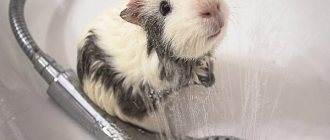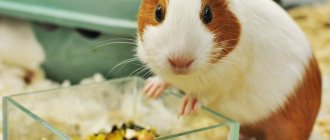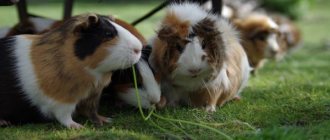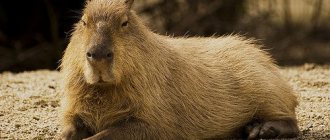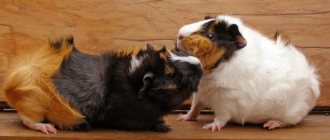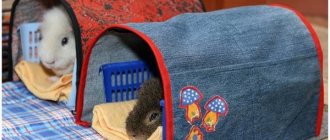Guinea pigs are increasingly becoming, one might say, members of Russian families.
Why are they so attractive? This is actually one of the best pets for kids. They never bite and are non-aggressive. However, in case of irritation, the maximum is capable of hitting the offender with his teeth. By the way, guinea pigs are very attached to humans and love to be petted. At the same time, they are very beautiful, so communicating with them is a great pleasure. However, like any other domestic creature, a guinea pig needs care. These creatures do not need walks, unlike dogs, and take up little space at home.
Adaptation to a new place
Until the animal feels completely safe, all attempts to tame a guinea pig will be in vain. Therefore, in such an important matter, you need to be patient, provide your pet with comfortable and calm conditions, and wait until he gets used to the new living conditions.
First of all, some conditions must be met:
- You cannot make noise near the cage;
- the drinking bowl and feeder should always be full;
- you need to arrange a shelter: a heap of hay behind which the animal will hide;
- the new resident must be isolated from other pets;
- people do not need to pet or forcibly hold the animal in their arms.
At first, the animal will naturally try to avoid contact with people. In the presence of strangers, the pet may even refuse food.
To facilitate the adaptation process, you can cover the cage or enclosure with a thin cloth.
Even if the pet does not show its anxiety, the owner must be as delicate and careful as possible.
The animal should not be disturbed for no reason, it should not be picked up, and there should be no sudden movements when cleaning the enclosure. In the first days of living in a new place, it is not recommended to let the animal walk around the apartment, because it may not find its way back. And the process of catching will lead to stress for the pet.
Other hygiene procedures
During bathing, it is recommended to empty the pig's anal pocket of accumulated feces. This is especially true for older individuals. The pocket is located in the anus area. The procedure is carried out by pressing on this area from both sides.
Villi and particles of hay often accumulate in the genital area of rodents. The area of contamination should be carefully cleaned of accumulated debris as necessary.
Taming methods
Over time and with the proper approach, the pet gets used to the person and is less afraid. After complete adaptation to the new place of residence, you can continue to tame the animal. In this case, the time spent can be very different, everything will depend on the nature of the pet.
Getting used to the owner
You can tame a guinea pig to its owner in stages:
- The owner should constantly talk to the pet in a gentle and calm voice, while simultaneously offering the animal treats.
- As soon as the animal begins to calmly react to the presence of a person, they move on to taming it by hand. To do this, open the cage door and offer the pet a treat, at the same time allowing you to sniff your hands.
- When the animal begins to calmly accept treats from human hands, you can try to slowly stroke it. However, to prevent your pet from perceiving your actions as aggression, you should not touch his rump.
- A little later, you can pet the animal without giving it a treat. It will gradually become clear whether the animal likes such actions or not.
- After mastering stroking, you can begin to pick up your guinea pig.
- In order for the adaptation to the owner to go smoothly, it is recommended to avoid situations that are unpleasant for the animal. Try to avoid actions that cause any discomfort to your pet.
- The cavey should be handled correctly, held and stroked in such a way that it feels good.
Getting to know the toilet
Many people are convinced that it is impossible to litter train a guinea pig. However, this opinion is wrong. Rodents have developed intelligence to understand where to defecate.
There are many different types of trays for pigs, but they are usually containers with a hole so that the animal can freely climb inside.
You can toilet train your guinea pig using granular litter.
It compares favorably with other materials in that it perfectly absorbs moisture. This means that such a filler will have to be changed quite rarely, thereby disturbing the pig less.
One of the most important points is choosing the optimal location for the toilet. You need to take a close look at the animal and understand where it goes all the time. It is recommended to place the toilet in this place.
Place some used litter in the tray. When the animal wakes up, you need to put it in front of the tray. By smell, he will quickly determine what the structure is intended for. If the animal refuses to go to the designated place, then you can install several toilets at once so that the animal chooses the one it likes. In this matter, it is very important to be patient, because gradually the pet will understand what’s what.
Parasites
A guinea pig may itch severely due to infestation with scabies mites. It settles in the deep layers of the skin and causes unbearable itching. The guinea pig begins to scratch its skin until it bleeds, the hair falls out, and pustules form. A guinea pig can become infected through food, hay, from other animals and even from people.
Another unpleasant parasite is the lice eater. With the help of a magnifying glass it can be seen on the skin of an animal. The pig's hair falls out, itching begins, and dandruff appears. The disease affects the back, perineum and croup. Mumps can become infected through food and from infected animals.
Severe scabies can be a symptom of a lice infestation. The pig's skin turns red and peels. The animal begins to behave strangely: jumps up, squeaks, and itches very much. You need to look for lice on the head and ears.
One of the most common parasites that affects guinea pigs is fleas. They bite pigs, causing them to itch. Flea bites can cause severe anemia. The pig loses its appetite, becomes lethargic and inactive.
Is your guinea pig itchy, eating little and drinking a lot? Perhaps she has worms. The parasite is very dangerous for guinea pigs. The animal begins to lose strength literally before our eyes, problems appear with the digestive system, in particular with the intestines.
What to do if your pig is afraid
Undoubtedly, it is easier to make friends with a young animal than with an adult. Adult pigs take a long time to get used to people.
Animals bought in a store are usually not sociable, because buyers do not always demonstrate friendliness and tact in treating them.
To avoid frightening the animal, try offering him treats only from your hands. It is also very useful to have conversations with your pet, sitting him on your lap and stroking him.
It’s good to place the cage for a while closer to the owner’s favorite place. Constantly being in the company of the owner, the pet will understand that there is no threat from this side.
However, cavey does not like to be held, not only because of fear. The reason may be independence and love of freedom. Keep in mind that not every pet wants to sit on your lap. If he bites his owner's clothes or skin with his teeth, it means he is uncomfortable.
It happens that a pet does not go to hand for a long time due to the fact that there is a house in the cage. Behind its solid walls the pig feels safe.
People who talk loudly and gesticulate intensely can frighten a guinea pig. Animals feel threatened by this behavior.
A hunched posture may not be due to fear, but to poor health. If this behavior is noticed in your pet, it is recommended to immediately consult a veterinarian.
Dental care
Kevy's front incisors grow throughout their lives. In the wild, rodents constantly wear them down. At home, for this purpose, you can give the animal something solid, for example, tree branches. It must be remembered that not all trees are safe for rodents; some are poisonous to them.
If an animal's teeth are too long, they can injure the animal and cause the rodent to die of starvation.
To avoid this, you need to visit the veterinarian once every 3 months to have the incisors filed.
Favorite caresses for a guinea pig
When petting your pet, pay attention to its reaction. Many pigs simply love to have the bridge of their nose stroked, their neck and the area behind the ears scratched. But if an animal pushes the hand stroking it with its head, it means it doesn’t like something. Guinea pigs also enjoy being petted on their barrels, just like cats. However, such caresses
The animal usually only allows it to a person whom it trusts completely and completely. Therefore, at the first stage of dating, such caresses are unacceptable.
Like dogs, pigs love affection, especially when they are petted and scratched near the ears. This area is highly sensitive, so don't overdo it. Monitor your pet's reaction until he puts your hand under your arm and you can safely continue.
When do they talk?
Any sound made by the pig indicates its mood at the moment.
There are several situations in which the animal will begin to make its loud voice. At the sight of the owner after his absence for a long time: the pig either rejoices at the meeting itself, or squeaks with pleasure in anticipation of the next delicacy. At such moments, she can stand on her hind legs, further attracting a person’s attention. By the way, the owner’s pet will greet him every time he enters the room, regardless of the time and frequency of visits. Pets often squeak when they are hungry. Babies are especially vocally active in the morning, when they are very hungry during the night's rest. “Pigs” beg with similar squeaks: they don’t want to eat, but they don’t mind eating something tasty. You shouldn’t follow the lead of the little tricksters - you’re not far from obesity. Uterine purring can be heard during or after eating; with this sound, pets express their pleasure from the feeling of fullness and demonstrate a wonderful mood. A menacing squeak or even a roar from a male in a large family is a warning signal to the rest of the family that it’s time to calm down and behave with dignity. With the same sound, the male shows his superiority over a weaker opponent. The animal experiences a feeling of fear or expresses dissatisfaction with what is happening. By the way, very often it is babies who are afraid, so at first it is better to keep them close to their mother - this way they quickly adapt to the world around them. When afraid, pets may hide in a corner or hide in a shelter. It is always worth finding out the reason for this behavior and eliminating it so as not to cause additional stress in the rodent. Another option why a guinea pig squeaks is that she was hurt or got sick. For example, with constipation, you can often hear the poor fellow's plaintive squealing.
Do not forget that by squeaking, whistling and other sounds the animal seeks attention and understanding.
How to hold a pig correctly
It is very important to learn how to properly hold an animal in your arms. Although this animal is small in size, it is relatively heavy. Therefore, if you hold him up, it may hurt him. Therefore, he must be able to rely on the owner.
So, let's learn how to hold a guinea pig in your arms correctly:
- one palm is placed behind the front paws, clasping the chest;
- with the other hand, carefully support the back;
- you need to hold the animal tightly, but not too squeezing.
The Cavie's build is not at all conducive to striking. A fall, even from the smallest height, can cause severe bruising, injury and lead to the death of your pet.
Bathing.
If there is a need to bathe the pig (and this should only be done in rare cases), then it is better to use warm water and baby shampoo. After bathing, the animal should be dried with a towel and placed in a room protected from drafts. This is due to the fact that after water procedures the pig can easily catch a cold. You can bathe a pig only if it is simply impossible to do without this procedure. For example, if the fur around the anus is dirty due to bowel movements due to diarrhea or the animal is very dirty in the ground.
Important nuances
Before taming a guinea pig, carefully study its behavior and mental characteristics. Undoubtedly, animals love:
- Peace and quiet. In a noisy environment, animals become restless, irritable and even aggressive. Working with an animal in such conditions is completely useless.
- The presence of a large amount of hay in the cage. Guinea pigs just love to burrow into the grass.
- Juicy vegetables and fruits, as well as a variety of greens, contain useful microelements that strengthen the immune system.
Some breeds of pigs are very picky about the temperature conditions in the room, they get cold and often catch colds. And when the pet feels any discomfort, taming classes are out of the question. You should never start playing with your guinea pig until it is accustomed to its new environment.
But when the animal’s adaptation is successful, when it is possible to tame the pet, the owner will find a faithful friend who will delight the owner and family members with games and tricks for many years.
Natural diet
What is a natural diet?
It means that the pig no longer eats store-bought dry food (pellets, grain mixtures).
What does a natural diet consist of?
Hay is unlimited, 24 hours a day, 7 days. This is the main food.
Branches from fruit and nut trees, along with leaves, help wear down the incisors and provide variety. Very thin, freshly picked branches are eaten well, while thicker ones are gnawed off the bark.
Grass and other green food, which should always be introduced gradually, after which it can be given in unlimited quantities (this is the most natural food for guinea pigs).
Plants, flowers, leaves, fresh or dried, can be given daily in small quantities (they contain all the vitamins and minerals a guinea pig needs to supplement).
Fresh food in the form of vegetables and fruits should be offered two to three times a day. It provides animals with additional vitamins and provides a tasty and healthy variety.
To ensure folic acid balance and help animals regain skin elasticity, 2 to 4 peeled sunflower seeds, half a teaspoon of fennel seeds, dill, flax, sesame, etc., can be offered once a week. Skin diseases can be prevented in susceptible animals in this way. .
If you feed fresh produce and grass, your guinea pig will get enough vitamins (including vitamin C) and minerals. They get enough fiber from hay. Vegetables such as carrots, dill, etc. also provide sufficient energy during the winter.
Hay Hay is a substitute for fresh grass. When dried, 40% less nutrients remain in the hay. Therefore, if possible, it is better to take fresh meadow grasses as the basis of the diet.
The hay must be of good quality, fresh, naturally dried, available to the pig 24 hours a day and must consist of various types of grass. Do not feed straw as it lacks nutrients. Alfalfa hay can only be used as supplementary food and in a mixture with other herbs and succulent food. Good hay keeps your pig's digestive system working 24 hours a day and ensures teeth wear down properly without overloading the bladder with excess calcium.
Before switching to a natural diet, you must be sure that your pig is eating enough hay to ensure the proper functioning of the digestive system.
Fresh herbs
Since the digestive system of domestic pigs is no different from the digestive system of wild pigs, fresh greens are the healthiest and most balanced food. The best greens for your pig are the ones she can find in nature: grass and leaves. If you have a garden, you can pick dandelions, plantain, clover, grass, wood lice, nettles, etc. If you do not have a garden, you should choose the greens that are closest to those named. This means you need to focus on foliage and limit root and bulbous vegetables. Herbs, various salads and their sprouts, sprouted grains, tops, herbs (dill, parsley, celery, fennel, cilantro, thyme, basil, etc.) should form the basis of the pig’s menu. Pigs can begin to eat succulent food from the first days of life. Training is carried out mainly through the mother and other pigs in the group.
Every day the pig should receive a variety of greens, which will satisfy all the needs of its body. Each meal should provide your pig with essential vitamins and nutrients.
Rule “ Diversity”
Each serving should contain a wide variety of greens and vegetables, at least 5 types are recommended, so that the pig can choose what she needs at the moment. The pig's feeding instinct is selective, so you can't force it to eat every last blade of grass, every last vegetable. Variety is also necessary to provide enough vitamins. A guinea pig that only eats apples and carrots is not getting enough nutrients. Which can cause health problems.
Attention : fruits and berries must be present in the diet as a treat. It is a source of many vitamins and minerals. If the pig constantly eats greens, then fruits and berries can be present in the diet 3-4 times a week in small quantities. Some pigs have a tendency to cheilitis, then fruit should be given less often. Quantity
If your guinea pig does not eat dry food, then he should receive succulent food every day in the amount of
20-30% of body weight. Considering that an adult pig weighs around 1 kg, this is approximately 200-300 grams. Divide the daily diet into 2 meals: morning and evening, adapted to the mumps regime.
Be sure to have good hay in unlimited quantities. It should be freely available at all times and at any time of the day.
Vegetables should be an everyday part of a natural diet. Over time, the pig will let you know what it needs and how it digests this or that juicy food.
Important! All changes in the diet must be made gradually. The transition from feed to natural food occurs within a few weeks. Sudden changes in the diet lead to digestive problems (bloating, diarrhea, constipation).
If you cannot provide your pig with such a varied selection of greens and vegetables, you should continue to feed her dry food (1 tablespoon of grass pellets per day) and always good hay. But try to give her greens and vegetables more often! Natural nutrition, like no other, is the key to the health of your pet.
Attention! Do not remove pelleted food from the diet of pregnant or lactating females or growing animals. A change in nutrition in this case (less fat, protein, calcium, etc.) can cause a sudden deficiency in weakened animals and those that require a lot of energy.
Why natural diet?
First of all, it is necessary to meet the needs of the guinea pig. In fact, the guinea pig is a strict herbivore, eating grass, leaves, branches, and roots. Unlike rabbits, they do not possess lactobacilli and produce propionic acid as a primary fatty acid. (Smith, 1965) Grains, various dry mixtures, and granules are not intended as staple foods. Pelleted food often contains too much calcium, protein, and consists, in particular, of grains... Grains, cereals are not the main part of a guinea pig's diet! It's even worse if you feed a grain mixture with added seeds, nuts, carob, etc. A diet high in calcium and protein can lead to digestive problems and bladder stones, as well as kidney and liver problems.
Moreover, when a guinea pig eats a lot of pellets, it overeats grains, quickly becomes full, and eats less and less succulent food and hay: this can lead to constipation and problems with bite.
Compressed pellets or grain mixtures often have high fat and sugar content. A guinea pig does not store food reserves in its cheek pouches or burrow, like a hamster; they are stored in adipose tissue. Industrial food is often a source of obesity and diabetes.
Finally, feed manufacturers add a bunch of additives (preservatives, colors, thickeners, flavors, etc.) that are not beneficial to animals.
Most dry guinea pig foods are fortified with vitamin C; removing these foods from the diet will not cut off the source. After all, it contains vegetables, greens and herbs.
How to get used to succulent food and switch to a natural diet?
You should always get used to juicy food with greens, and in no case with vegetables and fruits. Give 1-2 sprigs of dill a day and watch your appetite and feces. If all is well, then increase the portion and add other greens (parsley, cilantro, basil, lettuce, etc.). Also starting with 1 sprig per day. When you see that the reaction to greens is good, there is no bloating or diarrhea - within a week - then you can start giving green vegetables (celery, zucchini, cucumber). You also give a small piece and watch the chair. If the reaction to the vegetable is good, then increase the quantity. All this is also gradual over the course of a week. Only then come other root vegetables and colored vegetables (carrots, beets, pumpkin, Jerusalem artichoke, tomatoes, etc.). Also within a week. And only by the end of the month begin to introduce fruits into your diet, and then only if you have successfully switched to greens and vegetables. Otherwise, do not give fruits, they are too juicy and sweet. During all these days, reduce the amount of dry food as gradually as you introduce greens. Within a month, you can switch to a completely natural diet. There is no need to rush, it is fraught with chronic diarrhea and bloating.


